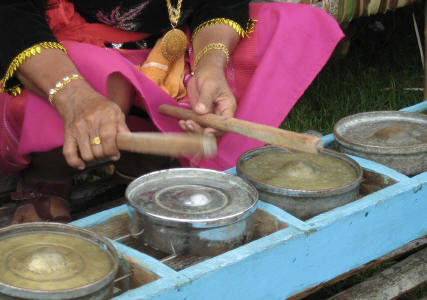
In Semporna, southeast of Sabah, the sound of drums and gongs usually heralds a Bajau Laut wedding or healing ritual in progress.
Tawau Division > Semporna Town > Regatta Lepa > Dance and music
Dance and music
of the Sea Bajau of Sabah

In Semporna, southeast of Sabah, the sound of drums and gongs usually heralds a
Bajau Laut wedding or healing ritual in progress.

Kulintangan:
The lowest-sounding gong is on the left, and the highest-sounding gong is
on the right end of the kulintangan.
LEPA festival is a tourism product in a class of its own. The festival
showcased characteristics of the Bajau culture.
Dance performances, traditional costume fashion shows and traditional Bajau
delicacies helped to preserve the culture of the community, and also introduce
the culture to other communities.
Malaysian Government Wants Arts to continue forming Modern Society. The
simultaneity of the kulintangan ensembles of the more than hundreds boats
partaking added up to an impressive soundscape of gong music, which also
incorporated quotidian sounds such as the shrieking voices of ice-cream vendors,
laughter of passersby, loudspeaker music and announcements, and bits and pieces
of conversation drifting by.
Music and dance were not staged performances here; they’re a natural part of
life, as essential, natural, remarkable, and, at the same time, unremarkable, as
conversation or gestures.
It is a form of communication and a matter of course when Bajau Laut are
congregating: wherever people come together for an occasion or an event, there
is music.
Music and dance evoke a shared cultural history that bonds and weaves the
present into it.
The dances and the gongs' sounds evoke the spirits and ancestors, involve the
elders and adults, and are a natural part of the environment in which the young
children grow up.
Indeed, intergenerational engagement can be observed everywhere. On every boat
are usually members of at least three generations, and it goes without saying
that the children observe and pick up their emerging performance skills from
their elders.
Tradition these gong instruments to be dwelling places of spirits; accordingly,
their use may bear a spiritual connotation.
The Bajau Laut are traditionally a nomadic seafaring group. Like their
land-settled cousins, the Bajau Kubang and West Coast Bajau who are settled
mostly in Kota Belud, they are rapidly losing touch with their traditions such
as the tarirai, other dance forms — like the limbaian and tabawan — and their
unique craft and pottery.
NAME OF BAJAU DANCES IN SEMPORNA:-
IGAL - A Bajau language mean 'dance'.
IGAL LIMBAYAN
This dance will only be presented by the ladies, which mean the smooth
mannered and courteous of Bajau ladies. Usually it will be performed during
wedding or welcoming the return of warrior.
IGAL TABAWAN
It will be performed during the wedding ceremony, Al-Quran performance
ceremony, and welcoming leader and quest. This kind of dance will be performing
by men and ladies.
IGAL TARIRAI
Tarirai is a best-past dance choreographed following one's reaction that
evolves around a story of one Bajau Semporna men. While walking on the sandy
shore looking for some cockles, he became terrifying upon seeing 'taliaga' (a
slimy snake like creature) and jumping around hysterically. He then ran home in
the same ticklish feeling. As it will be seen, the following foot works on this
dance are symbolism of one's feet during jumping.
IGAL SAYAU
It can be defined as an amok dance. So, it will only performed by the
Bajau men. The purpose of this dance is to generate the spiritual of Bajau
warrior before going to battle.
IGAL PANANSANG
The dance is usually presented by the witch for the purpose of quickly
recovering when medicate sickness. It is also a dance that tries to encourage
the sick person to strengthen himself to fight against the illness.

The Bajau were known as the sea-gypsies whose used to live their entire life on
Lipa-lipa boats. They were true nomads skilled in navigating the seas with no
compass on their boats.
The Bajau only came to land to collect fire wood, to get water, and to bury
their dead. However, over the past few hundred years some Bajau have settled on
the main land along the west coast of Sabah. And while the sea Bajau families
tend to be small, the land Bajau have enlarged their families.
A Bajau house tends to be large and spacious. They are still mainly fishermen,
and often build their houses on stilts into the sea or rivers, such as the Bajau
of Kg Mengkabong. Having had long contact with Chinese traders, but also with
European merchants, the Bajau have evolved particularly colourful costumes, with
elaborate accessories.
A Bajau lady in her full ceremonial dress move extremely graceful!
The Bajau have been Moslems for a long time, and through intermarriage with the
ruling Bruneis the settled Bajau have adopted many of their cultural aspects in
dance and music.

THAI DANCER
Thailand

LEPA DANCER
Malaysia
BALI DANCER
Indonesia
RELATED TOPICS
|
GO FURTHER ANIMALS
ENVIRONMENT HISTORY & CULTURE TRAVEL |
|
|
SEMPORNA |